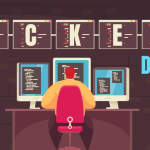Tech knowledge has tremendously expanded, and many software engineers or web developers now specialize in a particular tech area. As a result, several terms have been adopted to indicate the areas of specialization in web development.
The three terms used for web engineers or developers are front-end developers, back-end developers, and full-stack developers.
In this article, you will know who full-stack developers are, what they do and how you can become one.
Table of Contents
Who is a Full-Stack Developer?
Before you know who a full-stack developer is, let’s consider the meaning of front-end and back-end developers.
A front-end developer is a software engineer who creates or builds the visually appealing part of most websites and their applications. In addition, they design a user interface that allows users to interact easily with websites or applications.
The first page displayed by most websites, where you can easily interact and perform several other inbound tasks, is made by front-end engineers. Therefore, front-end web development is usually referred to as the client side.
Back-end engineers are involved in intrinsic web development. They are responsible for creating and maintaining architectural mechanisms that ensure accessible communication between the substituent units of a web. However, the users cannot see these units, which may include servers, databases, etc. Therefore, back-end web development is usually referred to as server side.
Full-stack engineers integrate the knowledge of front-end and back-end developers. As a result, they need to be more skilful in designing a web or application’s user interface and managing the coding logic, APIs (Application Programming Interfaces) and databases associated with the websites or applications.
What Does A Full-Stack Developer Do?
The responsibility of full-stack engineers is enormous because they work on the unseen and seen part of websites and applications. Before they finally release the products, they follow a regulated process popularly referred to as the Software Development Life Cycle (SDLC).
The cycle consists of six steps: analysis, design, development and testing, implementation, documentation and evaluation. This process helps web developers to create or deploy quality web applications. Some of the works of full-stack developers include:
-
Understanding the users
One of the essential works of full-stack developers is to understand the users of the project they are working on. They must know the tasks or functions the users want in their project and develop a final product based on that requirement.
-
UI/UX design
Most full-stack engineers understand that users are drawn to exemplary website/application interfaces. Therefore, they are knowledgeable in the basics of graphics. They can create a tremendous graphical layout for the web using HTML, CSS and JavaScript.
-
Data modeling
Data modelling is the process used to establish the data required for a project (web or applications). It includes knowing the best data implementation methods and selecting the best database method for the particular project.
-
Creation of APIs
Once they know the requirement, full-stack engineers create APIs by sourcing data from several places, harmonizing them, and deploying them. These APIs are made with a deep understanding of the function the project (web or application) will perform.
-
Network, hosting and servers
Full-stack engineers understand the relationship between networks, hosting services and servers. They know how to use network resources, cloud storage, and file systems.
-
Testing and debugging
Full-stack engineers test errors in codes and fix them before the deployment of the websites.
-
Version control
Through the use of version control systems like GitHub, Git, etc., the full-stack software developer can easily track and manage any alteration in coding even after the deployment of the project.
Read Also: How to Become A Mobile App Developer in Nigeria (Android, iOS)
What are the Skills Needed for Full-Stack Developers?
You must hone your hard and soft skills to have an excellent career in full-stack development. Hard skills show your expertise in handling essential tools, programs, software, etc. While soft skills are often people-related skills vital for full-stack engineers working in major software companies.
Full-stack development requires excellent coding knowledge and the arrangement of data in an organized and systematic manner for easy readability. In addition, full-stack development requires resolving any issue in web architecture and navigating web development tools seamlessly.
The following are some hard skills for full-stack development;
- Database storage solution skills, e.g. SQL, JSON and NoSQL
- Server usage skills, e.g. Nginx or Apache
- APIs skills, e.g. SOAP and RESET;
- HTTP protocol skills
- Front-end framework skills like React, Angular, Vue, Svelte, etc.
- Back-end management skills like software installation and distribution updates
The following are some soft skills for full-stack development;
- Communication skills
- Time management skills
- Growth mindset
- Creativity
- Organizational skills
- Problem-solving skills
- Adaptation skills
Read Also: 4 Simple and Crucial Steps to Become a Software Developer in Nigeria
What are the Most Common Languages for Full-Stack Development?
As a newbie in web development or software engineering, you need knowledge of front-end development. After this, you can learn about back-end development, enabling you to transition into full-stack development.
For this reason, you will need to understand the programming languages for front-end and back-end development.
-
Front-end development
You should learn HTML markup language, CSS cascading language and JavaScript programming language. Also, you need to know the basics of graphic design.
-
Back-end development
You should learn languages like Ruby, Python, PHP, Java, etc. However, you need to be specific and intentional, especially if you are a beginner. You can learn all these languages at different times. Therefore, you should choose just one and know the rudiments of its coding system.
Whether you start your back-end development journey with Python, which is easy to learn, or PHP, one of the most common languages for building responsive web, the choice remains yours. Only ensure that the language chosen aligns with your full-stack development career goals.
Therefore, the most common languages used by Nigerian full-stack engineers are HTML, CSS, JavaScript, Ruby, Python, PHP and Java.
If you like posts like this one, subscribe to our newsletter to get notified about new ones.
How Can I Become A Full-Stack Developer?

Today, full-stack engineers are the most sought-after developers because of their vast knowledge of front-end and back-end web development. Companies hire them because they prefer a single professional who understands the essentials of all web development architecture to someone who knows only front-end or back-end development.
Separately hiring a front-end developer and a back-end developer means the company will be paying double wages or income.
Becoming a full-stack engineer in a country like Nigeria is not a day’s work but comes with perks. Full-stack development is a highly lucrative career; the average yearly income of full-stack engineers is more than $100,000. In Nigeria, junior full-stack engineers earn an estimated 340,000 Naira per month. However, you must be willing to learn and practice what you have learnt if you will be successful. The following are the essential steps you must take if you want to become a full-stack developer:
-
Choose your learning platform
Several free and paid online resources will help you become a full-stack engineer. For example, you can search several free YouTube videos that teach the essentials of web development, and you can go to online sites like webdev, alxafrica, plurasight, coursera, frecodecamp, codecademy, etc.
-
Start from the rudiments
Starting from the rudiments means starting from what you know and steadily progressing to what you don’t know. For instance, if you are a newbie yet to grasp the concept of coding, you don’t have anything to do with learning highly logical programming languages like PHP.
You can start with HTML markup language. As a rule of thumb, learning HTML, CSS and JavaScript is the best way to get into web development as a starter.
-
Determine your career course
If you have mastered HTML, CSS and JavaScript, you can decide which programming language to learn for back-end development. Most people will go for PHP or Python, but it all depends on what you want.
Therefore, you should determine your career course or job prospects. For example, some jobs are highly sought for PHP developers. The same goes for Python. Ensure you choose the language you can quickly grasp and write.
-
Practice and improve your skills
There is more to full-stack development than knowing basic HTML, CSS and JavaScript. Hence the need to practice and improve your skillset. As you dive deeper into your journey, you will find out that you still need to know more about:
- Front-end styles: Material UI, Bootstrap, etc
- Back-end technology type: ASP.NET, Ruby on Rails, Node, Redis, etc.
- Databases: NoSQL (Elasticsearch, Mongo, CouchDB, etc.); Message Queues (SQS, RabbitMQ, Kafka, etc.); RDBMS (Mysql, MSSQL, etc.)
- DevOps: Infrastructure (ELK, AWS, Azure, etc.); Automation (Jenkins, Ansible, etc.); Virtualization (Docker, Vagrant, Bladecenter, etc.)
-
Build your portfolio
As you progress, applying for positions like junior web developers or any other entry-level position is good. These positions help to build your career portfolio by giving you the needed experience while you sharpen your skill to become a better developer.
Conclusion
Full stack development integrates the knowledge of front-end and back-end development. As a result, full-stack engineers are highly skilled professionals who create responsive webs and applications using programming languages like PHP, Python, etc. They know basic frameworks like Vue, Angular, etc. and styles like Bootstrap.
In most Nigerian software companies, full-stack developers are responsible for building the company’s websites, managing the database, debugging code errors during product development and controlling code alteration after product deployment.
You can hire a full-stack developer to build your products to save money and time. If you’re inspired by this article, you can become a full-stack developer so that you can become a master in web development.
Hey! Join the Insight Whatsapp Community right away. As a freelancer and an aspiring programmer, we have a lot to offer you.
About Author
- Olawale Moses Oyewole is a digital strategist who stays on top of current events and curate informative and engaging articles for his readers. He helps brand locate their target audience and enhance their online visibility.
Latest entries
 EntrepreneurFebruary 6, 2023A Comprehensive Guide to CPA Marketing in Nigeria
EntrepreneurFebruary 6, 2023A Comprehensive Guide to CPA Marketing in Nigeria EntrepreneurJanuary 22, 2023Content Management System: Types, How They Work and How to Decide for Your Business
EntrepreneurJanuary 22, 2023Content Management System: Types, How They Work and How to Decide for Your Business TechnologyJanuary 10, 2023Top 10 Budding Skills For Backend Developers in 2023
TechnologyJanuary 10, 2023Top 10 Budding Skills For Backend Developers in 2023 TechnologyDecember 31, 2022An Insightful Guide On The Functions of A Full Stack Developer in Nigeria
TechnologyDecember 31, 2022An Insightful Guide On The Functions of A Full Stack Developer in Nigeria

